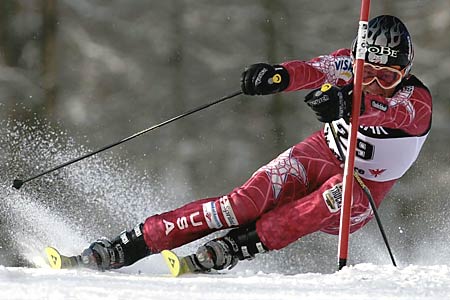Merchant and Turning

http://ski.mountainzone.com/2001/worldcup/alpine/valdisere/html/photo21.html
The centripetal force is limited by Merchants Metal Cutting theory. Merchant's theory will predict the maximum amount of force before the ski will fail to carve and start skidding. This force is broken down below.


http://users.wpi.edu/~brown/machining/sld001.htm
Although these may seem complicated, they are simple to see in the diagram above. The centripetal force is called centrifugal force (Fc) in the above diagram. The resultant force can be broken into several components, but there are four important ones. The centripetal force (Fc) and the thrust force (Ft). The centripetal force turns the skis and the thrust force is normal to the snow plane. The thrust force is the driving force that provides the penetration for the edge to bite the snow. These two forces are oriented in the snow plane. The two other important forces are the shear force and the force normal to the shear plane. These two forces again result in the same resultant force but are rotated into the shear plane. The angle of rotation into the shear plane is phi in above second diagram. Phi is the edge angle minus the angle in the triangle of the normal force(N) and the friction force(F) on the ski divided by 2. This can be seen in the first diagram. The centripetal force can be found using the above equations in the second diagram:
Fc=Fs*cos(phi)+Fn*sin(phi)
Fn=Fs/tan(O-b-F)
The Fc is the failing point at which the racer begins to slide the ski and lose speed. When a racer does balance the speed, radius, and other factors to maximize the centripetal force and acceleration, up to 2.5 Gs of acceleration can be achieved. Downhill ski racing is a ballet and balancing act of the laws of physics to be the fastest person down the hill.

http://ski.mountainzone.com/2001/worldcup/alpine/valdisere/html/photo35.html
HOME OR TURN BACK?
TWO ASPECTS OF DOWNHILL RACING: